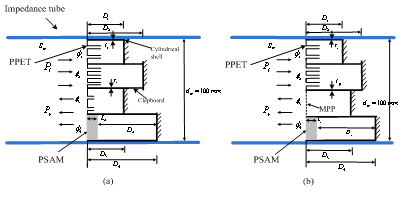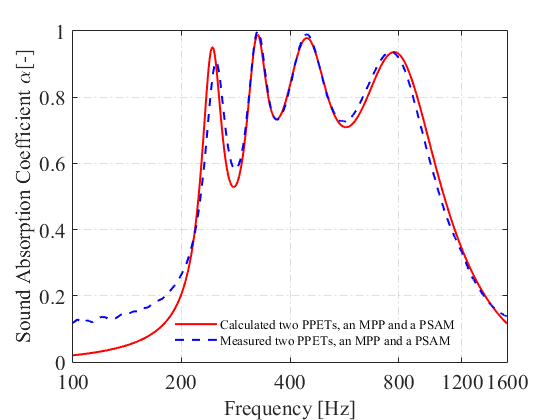Micro-perforated plate (MPP) is well-known for its wideband sound absorption compared to the traditional perforated plate. However, when the MPP is used to control low-frequency noise, large space is required; meanwhile, the bandwidth of sound absorption is limited. How to improve the low frequency sound absorptive performance of MPP remains unsolved.
Researchers LI Dengke and CHANG Daoqing from the Institute of Acoustics, Chinese Academy of Sciences investigate and propose a compound sound absorber, which comprised of perforated plates with extended tubes (PPET) and porous sound absorptive material (PSAM), to improve the sound absorption in the low- to mid- frequency range (100-1600 Hz) under the space constraint of about 100 mm depth.
The proposed combinations demonstrate superior sound absorption performance over more than three octaves in the targeted frequency range.
A theoretical model is described to predict the sound absorption coefficients of two combinations: one has three parallel-arranged PPETs and a PSAM layer (as shown in Fig.1a); the other one has two parallel-arranged PPETs, an MPP and a PSAM layer (as shown in Fig.1b).

Fig. 1. Schematic diagrams of two constructions of the proposed compound sound absorber:(a) three parallel-arranged PPETs and a PSAM; (b) two parallel-arranged PPETs combined with an MPP and a PSAM (Image by LI Dengke et al.)
The sound absorption coefficient is also measured in an impedance tube using the dual- microphone transfer function method.
Fig.2 shows the comparison of the calculated and measured results for the combination of three parallel-arranged PPETs and a PSAM. The three absorption peaks observed between 200Hz and 400Hz are caused by the Helmholtz resonances of the PPETs, while the resonance of the PSAM contributes to the forth peak observed at 700 Hz. The compound sound absorber has a good absorptive performance around the resonant frequencies.
Furthermore, the sound absorption performance can be further improved by the combination with an MPP, as plotted in Fig.3. The sound absorption trough at 400Hz in Fig.2 is greatly improved. The effective sound absorptive band is also much increased.
The predicted results agree well with the measurement in an impedance tube, which means the proposed combinations, when compared with the conventional absorbers, show much better sound absorption performance in the low- to middle- frequency range .

Fig.2. Comparison of the calculated and measured results for the combination of 3 parallel-arranged PPETs and a PSAM (Image by LI Dengke et al.)

Fig.3 Comparison of the calculated and measured results for the combination of 2 parallel-arranged PPETs, an MPP and a PSAM (Image by LI Dengke et al.)
Reference:
LI Dengke, CHANG Daoqing, LIU Bilong. Enhanced Low- to Mid-Frequency Sound Absorption Using Parallel-Arranged Perforated Plates with Extended Tubes and Porous Material. Applied Acoustics (Volume 127, December 2017, Pages 316–323). DOI: 10.1016/j.apacoust.2017.06.019.
Contact:
CHANG Daoqing
Key Laboratory of Noise and Vibration Research, Institute of Acoustics, Chinese Academy of Sciences, 100190 Beijing, China.
Email: changdq@mail.ioa.ac.cn


